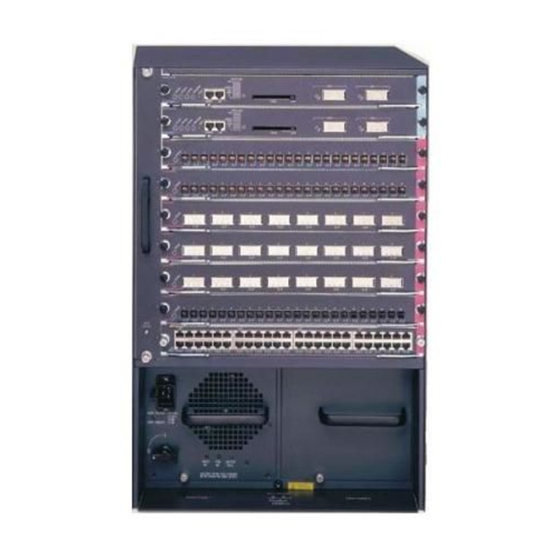Cisco WS-C6509 Технічний паспорт - Сторінка 15
Переглянути онлайн або завантажити pdf Технічний паспорт для Мережеве обладнання Cisco WS-C6509. Cisco WS-C6509 30 сторінок. Catalyst 6500 series
Також для Cisco WS-C6509: Посібник з оновлення (24 сторінок), Посібник користувача (28 сторінок)

How Accelerated Cisco Express Forwarding (aCEF) Works
Accelerated Cisco Express Forwarding (aCEF) technology uses two forwarding engines working together
in a master-slave relationship to accelerate high-rate traffic flows through the switch—a central CEF engine located
on the Supervisor Engine 720's PFC3 and a scaled-down distributed aCEF engine located on the interface module.
The central PFC3 makes the initial forwarding decision, with the aCEF engine storing the result and making
subsequent packet-forwarding decisions locally. aCEF forwarding works like this:
• As in standard CEF forwarding, the central PFC3 is loaded with the necessary CEF information before any user
traffic arrives at the switch.
• As traffic arrives on an aCEF720 interface module, the aCEF engine inspects the packet, and finding that
no specific packet forwarding information exists, consults the central PFC3.
• The PFC3 makes a hardware-based forwarding decision for this packet (including Layer 2, Layer 3, ACLs,
and QoS).
• The aCEF engine stores the forwarding decision results and makes forwarding decisions locally for subsequent
packets based on packet-flow history.
• The aCEF engine handles hardware-based Layer 2 and Layer 3 forwarding, ACLs, QoS marking, and NetFlow.
• The central PFC3 processes any forwarding decisions that the interface module's aCEF engine cannot handle.
aCEF-based forwarding requirements: Requires a Cisco Catalyst Supervisor Engine 720 and aCEF720 (WS-X67xx)
class modules.
How Distributed Cisco Express Forwarding (dCEF) Works
With Distributed Cisco Express Forwarding (dCEF), forwarding engines located on the interface modules make
forwarding decisions locally and in parallel, allowing the Cisco Catalyst 6500 Series to achieve the highest
forwarding rates in the industry. With dCEF, forwarding occurs on the interface modules in parallel and system
performance scales up to 400 Mpps—the aggregate of all forwarding engines working together.
Using the same ASIC engine design as the central PFCx, DFCs located on the interface modules forward packets
between two ports, directly or across the switch fabric, without involving the supervisor engine. With the DFC, each
interface module has a dedicated forwarding engine complete with the full forwarding tables. dCEF forwarding
works like this:
• As in standard CEF forwarding, the central PFC3 located on the supervisor engine and the DFC engines located
on the interface modules are loaded with the same CEF information derived from the forwarding table before
any user traffic arrives at the switch.
• As a packet arrives at an interface module, its DFC engine inspects the packet and uses the information
in the CEF table (including Layer 2, Layer 3, ACLs, and QoS) to make a completely hardware-based forwarding
decision for that packet.
• The dCEF engine handles all hardware-based forwarding for traffic on that module, including Layer 2
and Layer 3 forwarding, ACLs, QoS policing and marking, and NetFlow.
• Because the DFCs make all the switching decisions locally, the supervisor engine is freed from all forwarding
responsibilities and can perform other software-based functions, including routing, management, and
network services.
All contents are Copyright © 1992–2004 Cisco Systems, Inc. All rights reserved. Important Notices and Privacy Statement.
Cisco Systems, Inc.
Page 15 of 29
